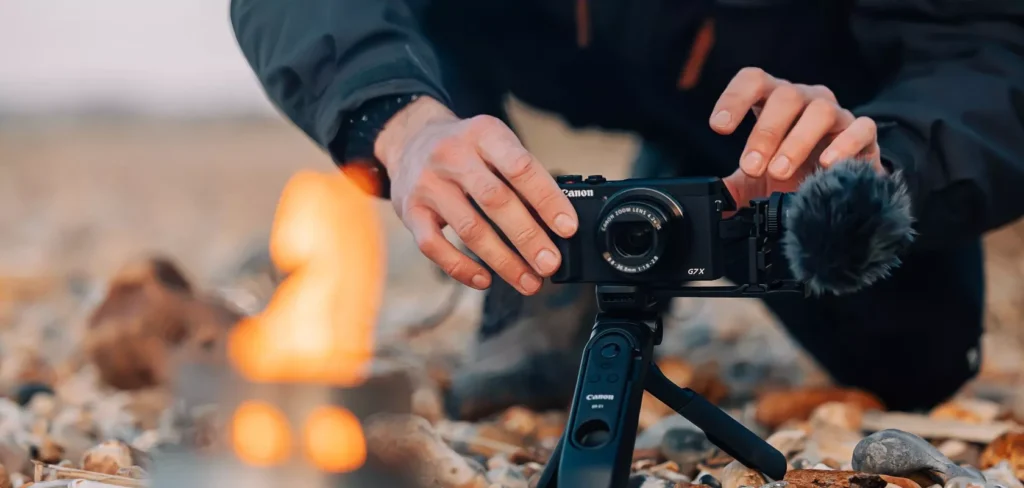In this Canon EOS R6 review, we’ll look at this mirrorless camera in detail and compare it to others like the EOS R, and EOS R5.
With the release of the EOS R5 and R6, things changed dramatically. Canon returned to its classic ergonomic design, added a slew of new features, and significantly improved autofocus performance, addressing all of the original EOS R’s shortcomings.
The addition of 5-axis IBIS was a significant move, as it was a feature that was already available on all other major cameras on the market from Nikon, Sony, Panasonic, and Fujifilm.
As you will see further down in this review, the IBIS system on both the EOS R5 and R6 is excellent, if not the best available.

Canon has always understood that high-performance lenses must accompany a powerful camera system, and it has invested heavily in R&D to create professional-grade RF mount lenses.
With a large inner diameter of 54mm and a flange distance of only 20mm, the RF mount allows for greater design flexibility in the construction of optics with larger rear elements and better performance than their EF counterparts.
Furthermore, because a new mount allows Canon engineers to completely rethink lens design concepts, the Canon RF 70-200mm f/2.8L IS USM and RF 70-200mm f/4L IS USM, both of which are the smallest 70-200mm zooms ever released, were released.
Canon has already stated that the mirrorless lens ecosystem will be its primary focus.
Canon EOS R6 vs. Canon EOS R5 vs. Canon EOS R
While the EOS R5 and R6 share a lot of technology, there are some key differences between the two cameras, especially when compared to the original EOS R.
First and foremost, there is a significant difference in sensor resolution. The EOS R5 is designed for high-resolution photography with its 45 MP sensor. The EOS R6 has a lower resolution of 20.1 MP and is geared more toward everyday and action photography needs. With its 30.4 MP sensor, the EOS R falls somewhere in the middle.

The in-body image stabilisation is another significant difference between the new line of cameras and the original EOS R. (IBIS). The R5 and R6 both have the new 5-axis IBIS, whereas the R relies solely on lens-based image stabilisation. This is a significant advantage for the R5 and R6, and should not be overlooked when deciding between these cameras.
Another significant distinction is in storage media. The EOS R only had one SD UHS-II memory card slot, whereas the R6 has two. To handle large 45 MP files, the R5 requires much faster storage, so it has one CFexpress and one SD UHS-II memory card slot.
If you are interested in videography, the EOS R5 is the best option because it is the only camera that can shoot 8K videos and does not crop videos when shooting in 4K. When shooting 4K videos, the EOS R has a significant 1.74x crop. At the same time, none of these cameras are ideal for professional videography because they overheat.
The R5 also distinguishes itself in terms of overall construction (full magnesium alloy vs partial), weather sealing (better than the R6), and other features such as EVF resolution and shutter durability.
Beyond the camera specifications, each system has advantages and disadvantages. In my opinion, Canon and Nikon cameras have far better ergonomics and a more organised menu system than Sony cameras. Sony, on the other hand, has a much better selection of native mount lenses from a variety of lens manufacturers due to being the market’s longest mirrorless player and having a more open system.
8-stop image stabilisation3
Imagine being able to shoot hand-held at shutter speeds of up to four seconds, blurring water in landscapes and people on the street without needing to reach for a tripod. That is the level of creative freedom provided by the EOS R6.
An in-body five-axis Image Stabilizer provides up to eight stops of camera shake protection. When RF lenses with an optical IS system (except the RF 600MM F11 IS STM and RF 800MM F11 IS STM) are attached to the camera, the two systems work in tandem to provide an incredible up to 8-stop advantage.

The camera’s in-body and lens-based IS systems both stabilise video. A third system, Movie Digital IS, adds another layer of stabilisation and professional-looking results.
The EOS R6 has a five-axis In Body Image Stabilizer (IBIS) that protects against camera shake when shooting with any lens mounted on the camera.
Because the sensor corrects for roll, X-Y, and pitch-yaw, all EF and RF lenses benefit from this new 5-axis correction for filmmakers and photographers alike.
When a compatible IS-equipped RF1 lens is used the camera and lens stabilisation systems work together to compensate for pitch-yaw movement. This result in an intelligent image stabilisation system that delivers new levels of image performance.

The RF mount has a large diameter, allowing the sensor inside the EOS R6 to move further within the lens’s image circle. As a result, certain lenses that lack optical IS can benefit from the up to 8 stop system.
When using RF lenses with Image Stabilizer, the in-body Image Stabilizer collaborates and effectively corrects camera shake. It RF lenses stabilize camera shake caused by breathing, walking, or simply holding the camera.
Correcting for low and high frequency movement in this manner provides new levels of stability. This can result in an incredible 8-stop advantage.
Image files of the future
Along with JPEG and CR3 RAW files, EOS R6 can now capture next-generation High Efficiency Image Format (HEIF) files. HEIF files have higher quality than JPEG files, but with a smaller file size and fewer artefacts. This future-proof format supports 10-bit colour for greater dynamic range and HDR PQ image capture.
Image processing that gives you a competitive advantage
The DIGIC X image processor in the EOS R6 is critical to the camera’s impressive speed and image quality. It allows photographers to apply sophisticated image processing in-camera or afterwards.
Thus, considering all of the above factors that distinguish the EOS R6, you may decide to purchase an EOS camera.
KNOW MORE ABOUT
Lenses click here
Accessories click here
Top 7 Canon Camera click here
Vlogging Camera click here

